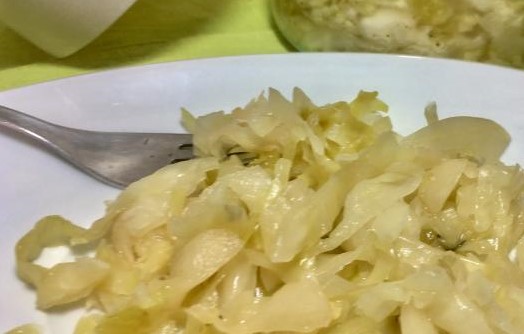In this article we present you the recipe for homemade sauerkraut, a natural food that comes from the fermentation of cabbage. This vegetable has great nutritional value and its beneficial properties are multiplied during the lactic fermentation process that results in sauerkraut.
This food acts as a powerful digestive that favors intestinal regulation. During the fermentation of the cabbage, the bacteria multiply, favoring the probiotic effect that is so beneficial to our microbiota or bacterial flora. These and other contributions are obtained especially if the sauerkraut is homemade, something that is very easy to do. For this reason, in this article we teach you how to make homemade sauerkraut, how to take it and what its benefits are.
Ingredients to make homemade Sauerkraut:
- 1 cabbage/white cabbage
- Coarse salt
- Pepper
- Laurel
How to make homemade Sauerkraut:
Remove the outer leaves of the cabbage, as they are usually spoiled. Cut it into quarters, remove the trunk from the center and cut it into very thin strips. Weigh the cabbage to know how much salt to use: if you have 1 kg of cabbage, it will be 20 g of coarse salt, approximately 2%.
Place the chopped cabbage in a large bowl with the coarse salt and spices of your choice and patiently mash the cabbage with your hands (or with a mallet) for several minutes, until a handful is squeezed and liquid comes out.
Place the cabbage in a large, wide-mouthed jar, squeezing it with a mallet or wooden spoon to expel any air and so that the liquid rises above the vegetables. If the liquid does not cover them, let it sit for about 5 hours. If the liquid released by the cabbage is still not enough to cover it, add a little chilled boiled water until it is covered. Make sure the jar is not filled to the top. Place a weight on top so that the cabbage is always submerged. Cover the container.
Every day remember to open it and cover it again, because in the fermentation process CO2 is produced that must be expelled (you will only have to do it the first few days). You can also cover it with a cloth instead of the lid, so you don’t have to uncover every day.
Store the jar in a cool, dry place, the ideal temperature is between 18°C and 20°C. Let it ferment for at least 2 weeks, but the time depends on your taste: the longer it ferments (even months), the softer the cabbage will be and the more acidic the taste will be.
Once it has reached the desired point, put the jar in the fridge so that the fermentation slows down. You can now serve it and enjoy it whenever you want. You can consume about 2 tablespoons 2 or 3 times a week in salads, vegetable recipes, etc.



